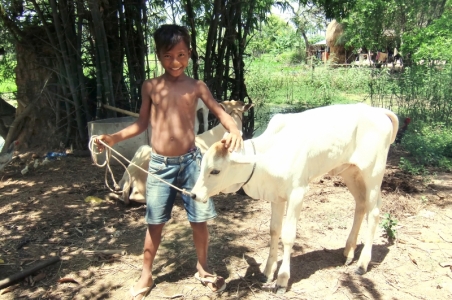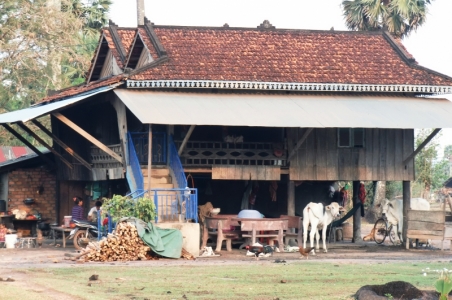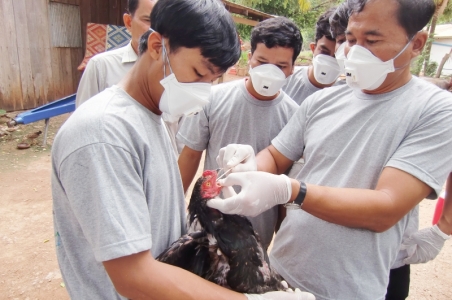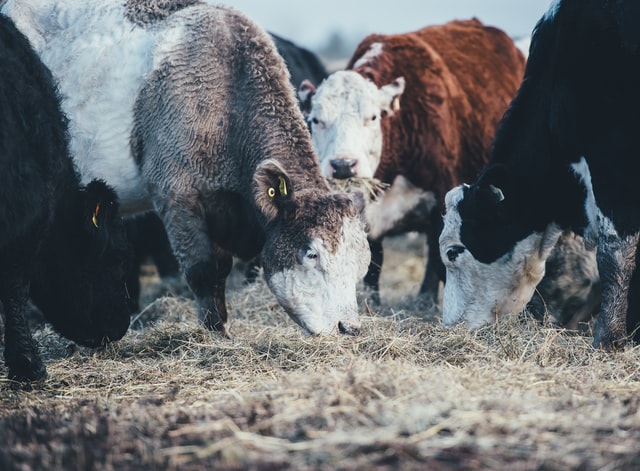In the movie Contagion, a sick bat falls into a pig pen and starts an epidemic that spreads around the world. While that story is fictitious, real-life has brought similarly troubling events, such as the “swine flu” pandemic in 2009-2010, with more than 18,000 human fatalities, or the H5N1 Avian Influenza outbreaks in poultry throughout Asia, Europe, the Near East, and Africa with more than 700 human cases.
Clearly, interactions between livestock and people can pose high public health risks. However, keeping animals for food production is an undeniable part of human reality.

Livestock rearing improves human nutrition, health status and livelihoods.
An estimated 1 billion people in low-income countries depend on livestock for their livelihoods. Animals provide food, energy (from biogas or burning dung), and a source of cash income, which can enhance vulnerable groups’ social status and offer pathways out of poverty. Farmers often keep multiple livestock species, and such diversification may reduce shocks from production losses and livestock diseases.
I spent six months as an animal health volunteer in southern India in the late 1990s. I found dairy farmers struggling to survive, but I also saw how milk cooperatives run by the farmers themselves were creating opportunities. Development interventions to improve the health of dairy cattle also improved the health of entire families. Those experiences stayed with me and brought me as a newly graduated veterinarian into the avian influenza programme of the Food and Agriculture Organization of the UN with field postings in Laos and Kenya. Since then, I have been working on infectious diseases in livestock in low-income countries.
So how do livestock diseases impact human health?
Livestock diseases affect human health through a variety of linkages. First, they may cause a decrease in milk, meat and egg production. Second, some diseases may be zoonotic – i.e. transmissible between humans and animals. Zoonotic diseases have been shown to disproportionally affect low-income areas, with the poorest people affected the most. Prevention of disease is preferred to treatment in order to limit losses, suffering, cost and drug-resistance. Control of zoonotic diseases is complicated, however, by poor understanding of the livestock-human interfaces.

Exploring human-livestock interface in Cambodia
I am now studying the interplay between livestock and humans in rural Cambodia, in a joint project between the Swedish University of Agricultural Sciences, Uppsala University, the Swedish Veterinary Institute, and in Cambodia the Centre for Livestock and Agriculture Development, the National Institute for Public Health, and the National Veterinary Research Institute, funded by MSB and Sida. Our focus is to describe risk factors for transmission of two zoonotic pathogens: Influenza A virus, causing flu symptoms in humans and livestock; and Campylobacter bacterium, which causes severe diarrhoea and abdominal pain in humans, but often infection without signs in livestock.
Campylobacter is a major cause of foodborne illness in humans – responsible for more cases of diarrhea than Salmonella – and the most common bacterial cause of gastroenteritis worldwide.
Cambodia is in a “hotspot” for emerging infectious diseases. Livestock is traditionally raised by smallholder farmers, in a management system that allows close contact with people. We have studied livestock rearing in three different regions of Cambodia and found that a vast majority of the farmers keep their poultry, cattle and water buffaloes free-ranging. In more than a quarter of the studied households, livestock was allowed to access cooking and sleeping areas. Slaughtering sick animals for consumption and eating animals found dead were common practices, particularly among poor and large households.
Interestingly, the farmers usually know that diseases can transmit between humans and animals, but they do not realize how often it takes place and do not take precautions. They don’t have enough knowledge about how diseases are transmitted, and have mainly received messages on hand-washing. Very few farmers are aware that animals without any signs of disease can transmit diseases to humans.
We found influenza virus in very few poultry and pigs in visited households. In contrast, the majority of poultry and pigs sampled were infected with Campylobacter and some humans from the same households tested positive for the bacterium as well. The figure was much higher in young children.
Campylobacter is the most commonly detected bacterium in children with diarrhea in Southeast Asia and infections are associated with under-nutrition and stunting. Under-nutrition is common among Cambodian children. The combination of under-nutrition and chronic diarrhoea, which can be triggered by Campylobacter, is estimated to cause almost 20% of all deaths among children under 5 in Cambodia.

Health and development pledge: understanding, outreach and collaboration
Improved hygiene practices and control measures for zoonotic diseases can really limit infection in humans and improve child health. Transmission routes for different pathogens are similar, so Campylobacter and Influenza A should be seen as model pathogens that we look at to enhance our understanding of the zoonosis transmission pattern. Precautions to limit transmission of influenza and Campylobacter will also limit the transmission of other zoonotic and non-zoonotic pathogens. Our knowledge on disease control may be applied in Cambodia, in low-income countries and globally. Moreover, safe livestock-human interface can mean better nutrition as well as higher incomes.
Many infectious livestock diseases have been diminished in high-income countries through a system of early warning, detection and control, as well as collaboration between human- and livestock health officers for control of zoonotic diseases. Such systems are slowly being established in low-income countries, through improved diagnostic facilities and capacity-building of health staff, but effective disease prevention measures reach farmers only to some extent, mainly because of the lack of funding and limited knowledge of disease transmission. At the same time, there is no enough understanding of how livestock are reared and what the drivers of farmers’ behaviours and practices are.
This is an ongoing project, and results are still preliminary. We need to better understand linkages between practices and pathogens. In the end, we hope to guide national and international extension services in achieving more effective zoonosis control so vulnerable groups like women at reproductive age and children can get access to the highly nutritious animal sourced foods without risk.
This blog is based on research paper “Zoonoses in Humans and Livestock in Cambodia, A Cross Disciplinary Approach” which will be presented at the 3rd International One Health Congress.
This blog is written by Kristina Osbjer. Kristina works for SLU as research coordinator for the project “Zoonoses in Humans and Domestic Animals – A Cross-Disciplinary Approach in Rural Cambodia” where she also conducts PhD studies. In addition she is enrolled at the Royal Veterinary Collage of London for a Certificate in Veterinary Epidemiology and Public Health.
